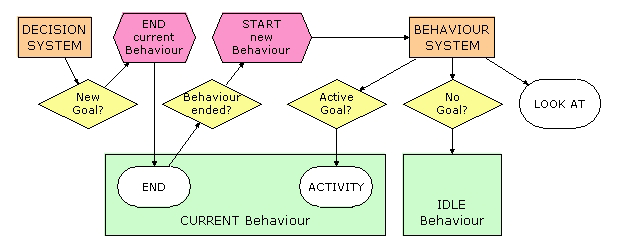
When a Goal has been selected, the Drama Princess system calls the Behaviour System. This makes the Actor play animations, move through space and trigger events. If the Decision Sytem is the brain, then the Behaviour System is the body.
Both the Decision System and the Behaviour System are called continuously for each Actor.
A Drama Princess Actor is stupid. He doesn’t know any Behaviours. The Behaviours are offered by the Objects in the game world around him in the form of Opportunities. When an Opportunity is selected by the Decision System as the Goal for the Actor, the Behaviour that corresponds to this Opportunity is loaded into memory. Only then does the Actor know what to do. When a new Goal is selected, the previous Behaviour is ended (if it hasn’t already) and it is replaced by the new Behaviour. The Actor doesn’t remember a thing. He remains an empty shell (that doesn’t take up too much RAM 😉 ).
A Behaviour is a little program that tells the Actor which animations to play, where to move to, what sounds to make, what events to trigger, etcetera. In its simplest form, a behaviour is basically a sequence of animations: “go to the table, pick up the cup, drink, put down the cup”. But it could contain more complex elements too: “find the nearest table” or “pick the cup that has water in it”. And also “reduce the amount of liquid in the cup” or even “make Johny look at me while I drink”, i.e. commands that affects other Objects than the Actor.
Every Behaviour also contains logic to end the Behaviour. This includes conditional logic to end the Behaviour at different moments. To end the “Go Sit down” behaviour while the Actor is still walking towards the chair, all that is needed is a “Stop Walking” command. But if the Actor was already seated, a “Get Up” command would be required. The Decision Manager waits for the Behaviour to end before it gives the Actor a new Goal.
So rather than making general structures in which to fit each behaviour, every Behaviour is a little unit on its own. This allows for infinite flexibility (we hope).
A behaviour can end when it is done, after which the Actor goes back to his Idle state. Or a behaviour can continue infinitely, until some external event forces it to end.
So far, there is one general system: the Look At system. It continuously plays, disregarding whether the Actor is doing a Behaviour or not. It makes the Actor look at certain positions in space. This is expressed as motion of the head. Different systems can tell the Look At system what the target of the Actor’s gaze should be: Shock events, for instance, or Behaviours themselves, or just a random function, to keep the gaze of the Actor moving around.
The movement of the Actor through space (position and rotation) is also defined in the Behaviour. It generally depends on the animation frame or time.
Behaviours can also call each other. The “Go Sit down” behaviour, for instance, starts with calling the “Go To Target” behaviour to move the Actor to the correct position.
The “Idle” behaviour is called when an Actor doesn’t have a Goal. Currently “Idle” consists of a few standing poses, some upper body activities (like scratching or yawning), looking around and some facial animations (blinking and smiling). All of these triggered randomly. I have noticed that there is a lot that you can do with this simple idle behaviour to make the Actor seem more believable. So it’s important to author and fine-tune this idle behaviour as well.
